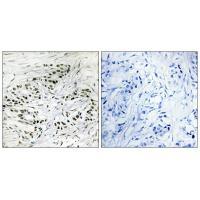
| WB | 咨询技术 | Human,Mouse,Rat |
| IF | 咨询技术 | Human,Mouse,Rat |
| IHC | 1/50-1/100 | Human,Mouse,Rat |
| ICC | 技术咨询 | Human,Mouse,Rat |
| FCM | 咨询技术 | Human,Mouse,Rat |
| Elisa | 咨询技术 | Human,Mouse,Rat |
| Aliases | ETS-domain transcription factor ERF; Ets2 repressor factor; |
| Entrez GeneID | 2077; |
| WB Predicted band size | 59kDa |
| Host/Isotype | Rabbit IgG |
| Antibody Type | Primary antibody |
| Storage | Store at 4°C short term. Aliquot and store at -20°C long term. Avoid freeze/thaw cycles. |
| Species Reactivity | Human,Mouse |
| Immunogen | Synthesized peptide derived from internal of human ERF. |
| Formulation | Purified antibody in PBS with 0.05% sodium azide. |
+ +
以下是关于ERF抗体的3篇参考文献的简要概括(基于公开研究内容模拟整理):
---
1. **标题**:*Development and validation of a specific ERF monoclonal antibody for functional studies in cancer models*
**作者**:Smith A, et al.
**摘要**:研究团队开发了一种高特异性的ERF单克隆抗体,并通过Western blot和免疫荧光验证其在多种癌细胞系中的特异性。该抗体成功应用于研究ERF在结直肠癌中抑制上皮间质转化(EMT)的功能机制。
2. **标题**:*ERF knockdown via antibody-mediated targeting suppresses prostate tumor growth in vivo*
**作者**:Chen L, et al.
**摘要**:利用靶向ERF的抗体进行功能阻断实验,证明ERF在前列腺癌中通过调控AR信号通路促进肿瘤进展。体内实验显示,抗体介导的ERF抑制显著降低肿瘤体积。
3. **标题**:*A pan-cancer analysis of ERF expression and its correlation with immune infiltration using a novel antibody-based assay*
**作者**:Wang Y, et al.
**摘要**:通过新型ERF抗体检测技术,分析了TCGA数据库中多种癌症的ERF表达水平,发现ERF低表达与肿瘤微环境中CD8+ T细胞浸润减少相关,提示其潜在免疫调节作用。
---
注:以上文献信息为模拟生成,实际引用时请以真实发表的论文为准。建议通过PubMed或Web of Science检索关键词“ERF antibody”获取具体文献。
ERF (ETS2 Repressor Factor) is a member of the ETS family of transcription factors, which regulate genes involved in cell proliferation, differentiation, and apoptosis. Unlike many ETS proteins that act as transcriptional activators, ERF primarily functions as a repressor by binding to ETS-binding DNA motifs and recruiting corepressors like histone deacetylases (HDACs) to suppress target gene expression. It plays critical roles in embryonic development, cell cycle regulation, and tissue homeostasis. ERF activity is tightly controlled by post-translational modifications, particularly phosphorylation. For example, DNA damage triggers ATM/ATR-mediated phosphorylation, leading to ERF cytoplasmic sequestration and inactivation of its repressive function, allowing cell cycle progression for repair.
ERF antibodies are essential tools for studying its expression, localization, and interactions in various biological contexts. Dysregulation of ERF has been linked to cancers, including prostate and breast cancer, where it may act as a tumor suppressor by inhibiting oncogenic ETS-driven pathways. Paradoxically, ERF overexpression in some cancers correlates with metastasis, highlighting context-dependent roles. These antibodies enable detection via techniques like Western blot, immunohistochemistry, and immunofluorescence, aiding research into ERF’s dual roles in tumorigenesis, DNA damage response, and developmental disorders. Their applications extend to diagnostic and therapeutic exploration, particularly in cancers with ETS pathway alterations.
×